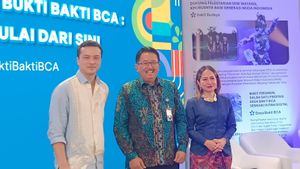
JAKARTA - The long debate about how to speak and hear the ancient Neanderthals and other human ancestors, slowly began to see a bright spot.
The new research results reveal that Neanderthals had a vocal communication system similar to modern human speech.
"Neanderthals can produce all the sounds in that frequency range, just as we can. There seems to be no difference in their ability to produce speech sounds. So they can definitely say 'hello' or 'okay' if the speech is done," said Rolf Quam, a professor and director of the evolutionary studies program at Binghamton University, New York, United States as reported by CNN.
Studying the evolution of language is notoriously complex, say the researchers, given that the soft tissues that make up the brain and voice channels are not preserved in the fossil record. Fortunately, the bones that make up the hearing system have been preserved.
With the help of CT scans, Professor Quam's team created 3-D models to reconstruct how early Neanderthals heard using information from the fossil ear structures of several Homo sapiens, Neanderthals and previous fossils from a group of hominins thought to be Neanderthals' ancestors.

They use this information to reverse engineer the way they communicate. Quam said the study was the first comprehensive study of Neanderthal hearing ability, considering more than 30 variables, including the ear canal, eardrum, ear bones and air-filled spaces in the ear.
They can measure how the energy in sound travels from the surrounding environment through the ear canal, to the eardrum, through the small middle ear bones until it reaches the inner ear, a process called sound power transmission.
This information helped the team calculate the bandwidth used, which is the range of frequencies that account for at least 90 percent of sound energy.
This is the frequency range we hear best. We still hear sounds outside of this range, but this range is a kind of 'sweet spot' where our ears are best suited for the sound, "explains Quam
They found that the bandwidth of Neanderthals was greater than that of the older hominin population. It is very similar to a living human and will cover most of the sounds emitted in human language.
The research, published in the journal 'Nature Ecology & Evolution', shows that Neanderthals were also able to use consonant speech, not just vowels.

"Many researchers now assume that Neanderthals had complex lives and would have developed speech skills," said Chris Stringer, leader of human origins research and professor at the Natural History Museum in London.
Recent archaeological discoveries show they wore jewelry, produced art and had rituals of their own, suggesting they were capable of thinking symbolically and cognitively on a par with early modern humans.
"Whether they have a language as complex as ours is not something that can be determined from this study because language is a product of the brain, not the vocal and auditory systems," said Stringer, who was not involved in the study.
Alexander Stoessel, an evolutionary biologist at Friedrich Schiller Jena University in Germany who studies acoustic communication, said he strongly agrees with the study's conclusions. But Stoessel, who was not involved in the study, noted that their model had made assumptions about 'soft tissue parameters' in the ear, something that can profoundly affect sound transmission.
Neanderthals and early Homo sapiens lived in some of the same places, and likely encountered each other for thousands of years before we emerged as the only surviving hominins. Sometimes they have children - the proof is in our DNA. Could they be chatting with each other?
"It's difficult to communicate with people from my neighboring country. I doubt they speak the same language but I think they can communicate one way or another," said Stoessel.
The English, Chinese, Japanese, Arabic, and French versions are automatically generated by the AI. So there may still be inaccuracies in translating, please always see Indonesian as our main language. (system supported by DigitalSiber.id)












